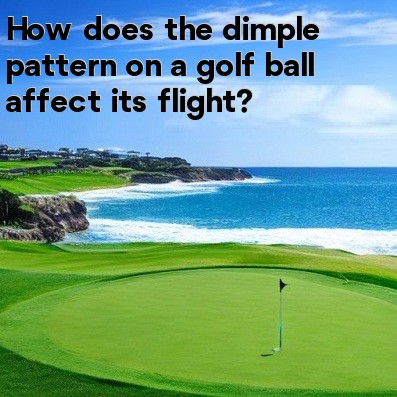
In golf, How does the dimple pattern on a golf ball affect its flight?
Aerodynamics play a crucial role in the flight of a golf ball, and the dimples on its surface are the key to its performance in the air. The dimple pattern on a golf ball affects various aspects of its flight, including lift, drag, and stability.
Lift:
The dimples on a golf ball help create lift as it moves through the air. When a golf ball is in motion, air moves across its surface. The dimples disrupt the smooth flow of air, creating turbulence. This turbulence leads to a lower pressure region on top of the ball and a higher pressure region underneath it. The pressure difference generates lift, similar to the wings of an airplane. This lift allows the golf ball to stay airborne and achieve a longer carry distance.
Drag:
The dimples on the golf ball also reduce the amount of drag it experiences during flight. Drag is the force that opposes the forward motion of an object, and in the case of a golf ball, it can significantly affect its distance and accuracy. The dimples create a thin layer of air that clings to the surface of the ball, reducing the drag caused by the turbulent wake behind it. By reducing drag, the dimples help the golf ball maintain its speed and travel farther through the air.
Stability:
The dimple pattern on a golf ball plays a vital role in its stability during flight. Without dimples, a golf ball would be prone to wobbling and inconsistency in its trajectory. The dimples disrupt the airflow around the ball, minimizing the impact of small imperfections in the ball's surface. This leads to a more stable flight path, resulting in greater accuracy and control for golfers.
Variations in Dimple Patterns:
Golf ball manufacturers have experimented with various dimple patterns over the years to optimize performance for different types of golfers and playing conditions. The number, size, depth, and arrangement of the dimples can vary between different golf ball models.
- Number: The number of dimples on a golf ball can range from around 300 to over 500. More dimples generally result in better coverage and enhanced aerodynamics.
- Size: Dimple sizes can vary, but they are typically between 0.1 and 0.2 inches in diameter. Larger dimples may provide more lift, while smaller ones can reduce drag.
- Depth: The depth of dimples also affects the aerodynamics of a golf ball. Deeper dimples can create more turbulent airflow, leading to increased lift and reduced drag.
- Arrangement: The arrangement of dimples on a golf ball can be symmetrical or asymmetrical, with various geometric patterns. These patterns can impact how the ball spins and flies through the air.
In conclusion, the dimple pattern on a golf ball plays a significant role in its flight. The dimples generate lift, reduce drag, and enhance stability. Manufacturers continue to innovate and refine dimple designs to optimize the performance of golf balls for different players and playing conditions. So, the next time you tee up, take a moment to appreciate the science behind the dimples on your golf ball.





